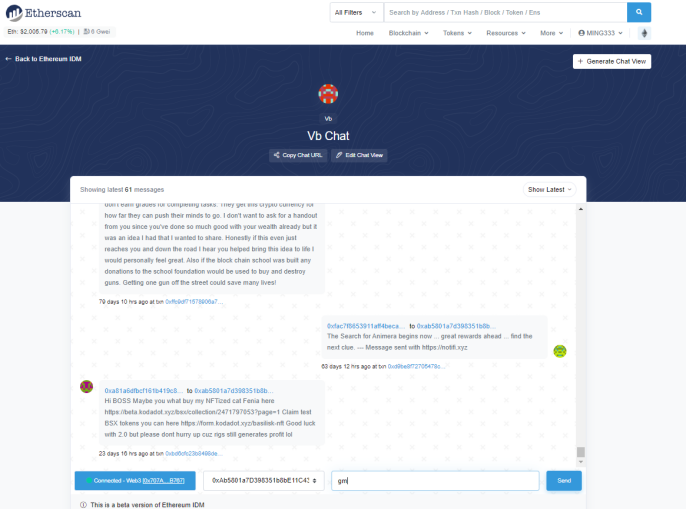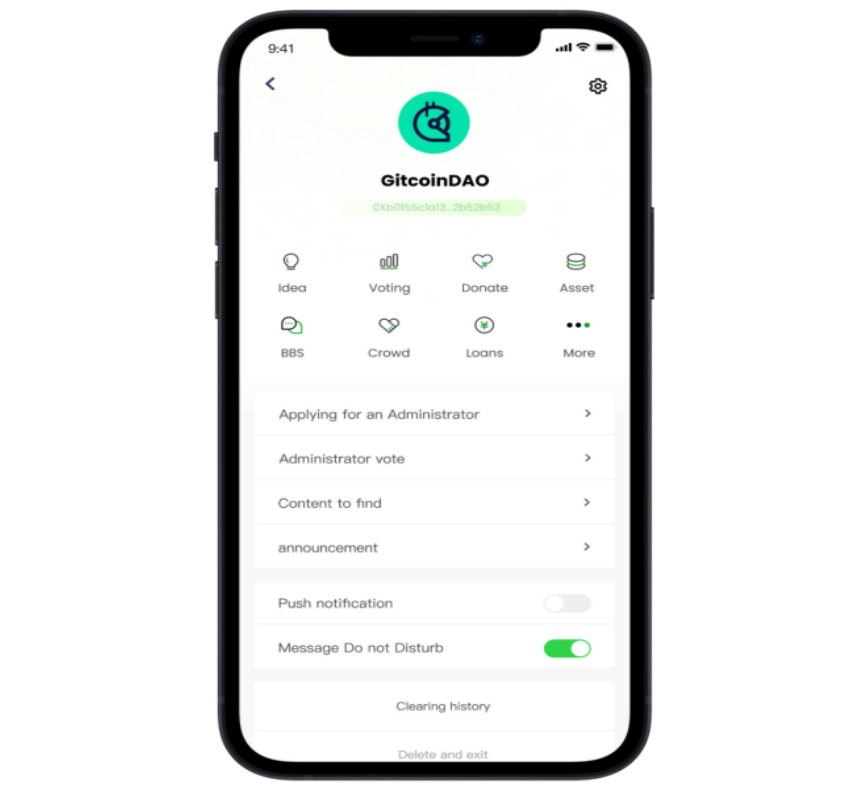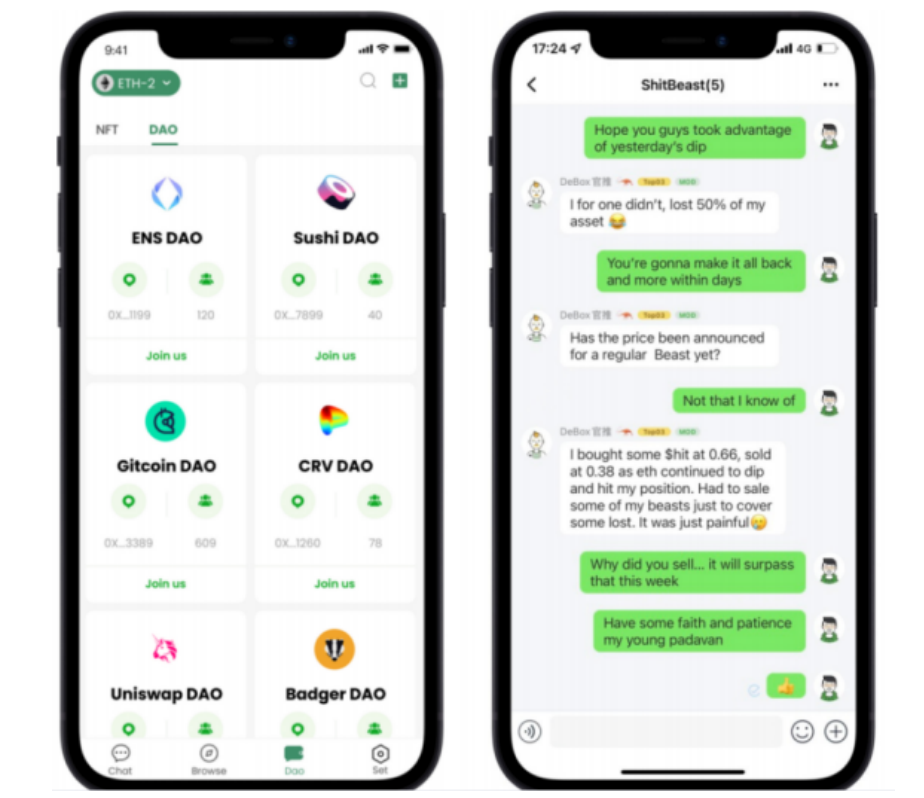Author:Crypto Ming | Translation: Jasmine I Date:24 sept. 2022
Abstract
Decentralized Identity (DID) is a novel and unique authentication and an essential infrastructure for Web 3.0, regardless of the practical application perspective to address Web 3.0 fraud and piracy, or the technical perspective to build a Web 3.0 world.
DID and DeSoc (decentralized society) are intertwined. One of the main portals for increasing traffic to Web3.0 is SocialFi. The current hotspots in the SocialFi sphere are projects like the social platforms. There are two different kinds of social platforms: ones for building relationships (Blockscan Chat, Atem, etc.) and ones for creating content (Mirror, Monaco Yacht, etc.). Both, however, currently have certain limitations.
DeBox describes itself as a DID-based blockchain community management solution. By presenting captured on-chain data (DID) in processes like voting and governance in decentralized autonomous organizations (DAOs), it enables token-holding users to make more wise decisions. The primary application of DIDs in DAOs is made through this method, which its Web 3.0 world desperately needs.
DeBOX is a relationship-based social platform in SocialFi that differs from the "content creation social platform" as it receives less attention but more needs. DeBOX launched Pop-up room and voice services in order to effectively attract new customers from public traffic. Even though tokenomics of DeBox in SocialFi are fairly simple, the user experience in the social sphere of its APP is great and in line with user habits in Web3.0.
DeBox's future is mostly seen in 2 directions:
-
To facilitate DAO governance, introduce or upgrade more sophisticated DIDs.
-
Explore and practice further to boost traffic and user volumes.
I. DID is a critical element for Web3.0's infrastructure
In the paper "Decentralized Society: Finding Web3's Soul," Vitalik Buterin suggests using a token called Soulbound Token (SBT) that cannot be transferred. SBT will be utilized to develop Web3's user identity system and can represent qualifications, credentials, and credibility, etc. In fact, Vitalik's proposed SBT is a type of DID (Decentralized IdentiFier).
Decentralized Identity (DID) is a novel and unique authentication. It should integrate off-chain and on-chain proofs. A user's assets or wallet dynamics are validated on-chain, while their social media profiles are verified off-chain. In Spruce ID, for instance, users are required to validate both their wallet signatures and personal Twitter, GitHub, and other accounts that can attest to their social information.
The use of and popularity of DID in Web 3.0 are urgently needed in terms of its application. Since the high cost of crime, there won't be widespread fraud and piracy in the Web 2.0. For instance, because those activities will be restricted by legislation and centralized personal identity. On the other hand, employing a wallet address makes it simple and cheap to commit fraud and infringement in Web 3.0. The wallet address can be freely discarded without really having an impact on prominence and reputation. In contrast, there isn't a commonly accepted method for users in Web 3.0 who want to develop and present their personal prominence and reputation.
The Web 3.0 DID is presently still in its infancy and is scattered, despite that there are already some applications for on-chain identity credentials or proofs. The On-chain Identity Landscape in Web3.0 is depicted in the diagram below, which Shrey Jain compiled. It is anticipated that DID will one day have ground-breaking applications in DAO, DeFi, and SocialFi.

DID is also a vital element of a new layer of public key infrastructure (PKI) and digital identity in decentralized web (Web 3.0).Similar to SSL/TLS protocol (the largest PKI in use today) in Web 2.0, this decentralized public key infrastructure (DPKI) in Web 3.0 has a significant impact on online privacy and network security throughout the world. DID is thus one of the fundamental technological and application foundations in Web 3.0.
DID is a decentralized proof of identity and social property is the essential component of identification proof. And we have to provide identity proof in our daily interaction with society. Additionally, in order to interact with society on a regular basis, we must show identification. Thus, DID and DeSoc (decentralized society) are intertwined.
Ⅱ. SocialFi is the focus of the upcoming Web 3.0 phase
CZ, CEO of Binance, says that SocialFi and GameFi will likely be the major factors fueling crypto pemeability growth in 2022 in the article published in Fortune India. SocialFi is one of the Web 3.0 traffic portals. Traffic represents growth. Therefore, Web 3.0 can only become vibrant with an expanded market.
In fact, there has been an ongoing exploration regarding SocialFi in the crypto sphere. Before the DeFi Summer in 2020 and the NFT craze in 2021, the amount of on-chain users, on-chain applications and on-chain events were all very small. SocialFi wasn't in particularly high demand at the time in the crypto market. Social media platforms like Status and Keybase had as a result been created. But they continue to adopt the viewpoint and methodology from Web2.0 and do not introduce on-chain events or data. As a result, they had been eliminated from the entire field then.
The crypto industry is rapidly advancing in Web3.0 in 2022. Web3.0 has a specific user cardinal number and on-chain data, however DeFi's financial and NFT's social properties need a platform to integrate both. Therefore, the development of SocialFi is crucial for Web3.0. There isn't really a standout project in SocialFi currently, and the majority of projects are still in the exploration phase. Consequently, there are numerous possible investment opportunities for institutions.
By function, there are 4 types of Web 3.0 SocialFi projects:
-
Infrastructure: Mask Network ,Deso
-
Social platforms: BBS, Monaco Yacht , Blockscan Chat (developed by Etherscan team), Atem, Lens, etc:.
-
Publish platforms: Mirror, Rally, P00Ls, etc..
-
Individual tokens: RAC, etc.
Social platforms are one of the trendiest niches in the SocialFi and are one of the most pressing user demands in Web 3.0. According to user needs, there are two types of social platforms: one is for creating content (Mirror, Monaco Yacht, etc.); the other is for building relationships (Blockscan Chat, Atem, etc.).It is clear that users' main goal on a platform for content creation is to obtain content. Even if a long-lasting bond develops during the encounter, it makes it easier for them to get access to further information. How about the relationship-based social platform? In a nutshell, it is a tool that users can employ to create or maintain relationships and connections with other users. It places a focus on real-time or immediate encounters. For instance, Atem allows users to conduct C2C NFT transactions through chat.

Early social platform usage showed that the content creation platform was more based on the Fi property, which led to a negative user experience for the bulk of users. The initial way to obtain Write tokens on the decentralized creation platform Mirror was through routine weekly voting, which generated to an enormous volume of spam articles and bot voting for token acquisition. As soon as the project team was aware of the issue, the rule was dropped in favor of content creation.Monaco Yacht, a 3AC investment, focuses too much on the Fi property (which is overloaded with spam content generated by content mining), that also makes it weak at capturing value.
Traffic will be limited if on-chain interactions are only social (Blockscan Chat - created by Etherscan team, Lens). On the one hand, it's unfriendly to novices, but on the other, while sounding cool, no one would pay Gas for shouting "GM" on the IDM of Blockscan Chat. Additionally, you don't want to be loathed simply for having a brief movie inside Lens (the data on the chain is transparent).

In summary, even if SocialFi is a traffic portal for Web3.0, the social experience in Web3.0 is currently not very user- or institution-friendly. Since SocialFi is still in its infancy, many issues still need to be addressed.
III. DeBox - DID-based community management tool in Web3.0
DeBox describes itself as a DID-based blockchain community management solution. Given that DeBox is a community management tool, let's presume that DeBox is benchmarked against Telegram and Discord, the social and community management tools that are widely used by users in Web 2.0. There is currently no direct link with Web 3.0, and the two most popular Web 2.0 platforms have issues with information authenticity and fraud environment regulation. How does DeBox deal with this issue?

The "ownership" section is displayed in the DID's On-chain Identity Landscape in Web3.0, as previously illustrated (Figure 1.). The easiest data to obtain is a wallet's on-chain data, which includes transactions, NFT holdings, and other crypto assets. By connecting wallet addresses with personal identities via "ownership," DeBox makes it simpler for individuals to establish their reputations and take part in community governance.
Here is DeBox's perspective on DAO in addition. A user accesses the token's DAO by holding the token. The native DAO is the type of DAO composed of token holders. For instance, when the Constitution DAO completed its goal to raise money through a crowdfunding auction, the holders of its token (PEOPLE) spontaneously established the PEOPLE DAO. This is the holder's entitlement as defined by PEOPLE tokens; no individual or institution needs to verify him or her. This is where DAO's appeal comes into play.

In DeBox, only certain token holders (those with token vesting rights) are able to join the relevant community (native DAO). It assists users in separating more than 90% of pointless contact of spam. The user can participate in discussions and governance votes in the community (DAO) with a more genuine reaction if their open position ranking is made visible (identity display) once they are there. And the user would have to automatically exit this community once they sell or transfer their token (DAO). The DID has achieved the main application for DAO through the aforementioned process. The Web 3.0 world need a situation such as this.

IV. How does DeBox navigate the SocialFi in a novel way?
- Application positioning of DeBox
As previously noted, SocialFi's majority of social platforms still prioritize content creation nowadays. Despite fitting the Web3.0 description of the creator economy, the outcomes are subpar. DeBox, on the contrary , has turned around. It focuses on the underdeveloped but highly demanded relationship-based social platform known as "immediate social." To achieve one-to-one, one-to-many, and many-to-many multiform information transfer, "Immediate Social" pays closer attention to the frequency of users' social behavior and online time. This is our DAO, particularly for Web 3.0. As you are aware, joining a DAO serves a variety of objectives, including an important role in information exchange as well as participation in voting governance. DeBox is the ideal solution for this issue.
- Traffic attraction method of DeBox
As explained previously, SocialFi is one of the traffic portals for Web3.0. How therefore can DeBox meet the demands of Web3.0 users while boosting to DeBox and Web3.0? A Twitter Space user perhaps notice that it's a fantastic place to bring traffic. People would follow the speakers' Twitter accounts if their remarks are interesting, attracted by KOLs or event topics. Pop-up rooms and voice services were launched by DeBOX in order to effectively attract new customers from public traffic and assist users in locating chances to rapidly discover about and take part in new projects to receive early airdrop.

The entrance point for DeBox in the social section of SocialFi is great, as is evident from the analysis above. What about Fi then? DeBox's white paper explicitly refers to DBX as its governance token, while it also stresses that this is not required. DeBox's tokenomics is indeed simple. The white paper identifies "Deflation" and "Staking" as the two primary uses for DBX tokens. The business (projects) is the goal of the deflation, and the clients are served through "Staking" ( users ). The token DBX is easier to obtain if users join the DAO they hold the token for or check in daily. This non-tasking token acquisition method can lessen stress and hostility. This way of non-tasking token collection can reduce tension and antagonism. Its Fi model is simple and therefore can give users a more pleasant experience, by contrast to the "chat mining" project.
Furthermore, with its Web 3.0 interface in the APP, DeBox allows users to engage in real-time on-chain conversation and enjoy DID-based DAO social engagement. Switching between different APPs is not at all necessary in this procedure to assure user experience.
Consequently, DeBox is exploring a new approach in the SocialFi. The APP has reached the cold boot stage and is available for download and use on the official website. The DeBox crew has demonstrated their remarkable sincerity in comparison to certain projects that merely deploy sliders. If the team enhances its operation and optimizes its product, DeBox definitely has the potential to be one of the popular social platforms in Web3.0.
V. DeBox product prospects
-
To accelerate the adoption and ubiquity of Web3.0 DID and introduce a more sophisticated or interface to improve the standard and reputation of community management (DAO).
-
Traffic is the lifeblood of every social platform, hence DeBox needs to do more investigation and practice gaining attention and accumulate users.
Disclaimers
The above market analysis and content is provided for informational purposes only and should not be used as a basis for any investing decisions. The authors of the paper and DeBox Institute are not liable for the user's investment outcomes, therefore don't base any decisions on them. Any purchase or sale based on the projects mentioned in this report is at your own risk and comes with no advise.
The assertions made by this report involve predictions of the future and forward-looking statements. If the opinions and assumptions in this article differ considerably from the outcomes, performance, or events as the numerous uncertainties and risks involved, the writer gives no assurance to the user that no loss or minimum reward will be achieved. The writer of this report has cited a few other papers and included the pertinent links. Please contact with the writer as soon as possible for any infringement of copyright content amended or removed.
Author: